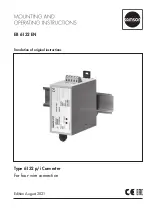
12
WIRING
*1
The terminals R1/L11 and S1/L21 are connected to the terminals P/+ and N/– with a jumper respectively. When using separate power supply
for the control circuit, remove the jumper between R1/L11 and S1/L21.
*2
The function of these terminals can be changed with the input terminal assignment (Pr. 178 to Pr. 189). (Refer to
.)
*3
Terminal JOG is also used as the pulse train input terminal. Use Pr. 291 to choose JOG or pulse.
*4
The X10 signal (NC contact input specification) is assigned to the terminal MRS in the initial setting. Set Pr. 599 = "0" to change the input
specification of the X10 signal to NO contact.
*5
Terminal input specifications can be changed by analog input specification switchover (Pr. 73, Pr. 267). To input a voltage (0 to 5 V/0 to 10 V), set
the voltage/current input switch OFF. To input a current (4 to 20 mA), set the voltage/current input switch ON. Terminals 10 and 2 are also used
as a PTC input terminal. (Pr. 561) (Refer to "FR-A800 Instruction Manual (Detailed)".)
*6
It is recommended to use 2 W, 1 k
when the frequency setting signal is changed frequently.
*7
The function of these terminals can be changed with the output terminal assignment (Pr. 195, Pr. 196). (Refer to
.)
*8
The function of these terminals can be changed with the output terminal assignment (Pr. 190 to Pr. 194). (Refer to
.)
*9
No function is assigned in the initial setting. Use Pr.192 for function assignment.
*10
The terminal F/C (FM) can be used to output pulse trains as open collector output by setting Pr. 291.
*11
Not required when calibrating the scale with the operation panel.
*12
Upon delivery the FR-A800-E-R2R inverter models are not equipped with the RS-485 terminal block.
*13
For FR-A800-E-R2R: The option connector 2 cannot be used because the Ethernet board is installed in the initial status. The Ethernet board
must be removed to install a plug-in option to the option connector 2. (However, Ethernet communication is disabled in that case.)
CAUTION
O
To prevent a malfunction due to noise, keep the signal cables more than 10 cm away from the power cables. Also, separate the main circuit
cables at the input side from the main circuit cables at the output side.
O
After wiring, wire offcuts must not be left in the inverter.
Wire offcuts can cause an alarm, failure or malfunction. Always keep the inverter clean.
When drilling mounting holes in a control box etc., take care not to allow chips and other foreign matter to enter the inverter.
O
Set the voltage/current input switch in the correct position. An incorrect setting may cause a fault, failure or malfunction.
















































